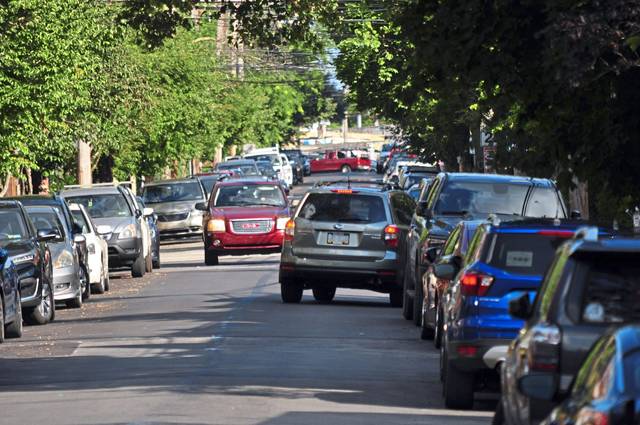https://triblive.com/local/carnegie-mellon-researchers-teach-autonomous-vehicles-to-navigate-narrow-car-lined-streets/
Carnegie Mellon researchers teach autonomous vehicles to navigate narrow, car-lined streets

Driving through Pittsburgh’s narrow, car-lined streets can pose a challenge to even experienced drivers.
It’s a particularly difficult situation to teach to autonomous vehicles without a human driver behind the wheel.
A team of Carnegie Mellon University researchers at the Argo AI Center for Autonomous Vehicle Research developed an algorithm to teach autonomous vehicles how to navigate those narrow, crowded roads.
The team of researchers recently presented their study — titled “Learning to Robustly Negotiate Bi-Directional Lane Usage in High-Conflict Driving Scenarios” — at the International Conference on Robotics and Automation.
Research on automated driving typically focuses on scenarios with a clearly defined set of traffic rules — and autonomous vehicles should “put safety first and follow all traffic rules,” said Christoph Killing, a lead researcher on the project who is now part of the Autonomous Aerial Systems Lab at the Technical University of Munich.
“However — and this is the beauty and challenge of the scenario considered — there exists no coordinating traffic rules in this kind of scenario,” Killing said of the narrow, crowded street dilemma. “Here, two vehicles of equal right of way have to negotiate essentially who goes first and who waits.”
On many residential roads where cars line one or both sides of the street, human drivers negotiate a choice of pulling over to let another car pass or driving through if another car pulls over to make room. Killing’s research focused on teaching self-driving cars to navigate the same decisions, where there are no specific rules to govern who waits and who goes.
If both vehicles are trained to focus purely on safety, they’ll both pull over and neither will make it through the road, Killing explained. But on these narrow roads, they can’t both proceed at the same time either.
“The key challenge we were faced with in our research was how do we make one vehicle pull over and one go — not both pull over, not both go — when each makes their own decisions without any coordinating instance,” Killing said.
They modeled varying degrees of cooperation or aggression of each driver to train the artificial intelligence to negotiate the scenario successfully in over 99% of cases when they don’t know how cooperative or aggressive the other driver may be, Killing said.
Teaching autonomous vehicles to navigate these driving complexities helps solve the “last mile problem” of autonomous driving, Killing said. While most autonomous car research has emphasized highways and intersections, it’s also important to teach the technology how to navigate scenarios such as this one if these cars will one day be able to adeptly handle residential roads and complex situations.
There are other similar scenarios where an autonomous car may also need to negotiate interacting with other vehicles in a way that may not be as simple as other hard-and-fast rules of the road, Killing said.
One such example, he noted, is the “Pittsburgh left,” where vehicles in the left turning lane often turn immediately when a light turns green, expecting the oncoming traffic to wait for them to make their turn though the oncoming vehicles have the right of way.
Copyright ©2025— Trib Total Media, LLC (TribLIVE.com)
